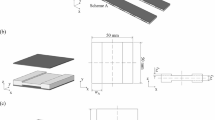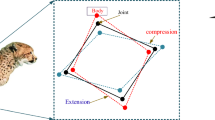Abstract
Moulded elastomeric vibration isolators used in aerospace applications are studied for predicting transient vibration response to typical excitations. Vibration isolators used in the present study undergo non-linear static deformations followed by transient dynamic loads. Static deformation is imposed by the specified displacement during assembly of metallic steel parts of isolator, and a static inertial load is applied as the load rating of the isolators. Statically deformed state is obtained using total Lagrangian approach assuming Hookean material model for metallic parts and Yeoh material model for elastomers. Steel properties are used from the literature, and Yeoh material constants are obtained from uni-axial tension test data of elastomer specimen. For transient response study, dynamic elastomeric constants are obtained from test in a Dynamic Mechanical Analyzer as a frequency–dependant complex function. To account for the pre-deformed state of elastomers, the Yeoh material constants are modified which includes frequency–dependant material characteristics and damping in the range of interest using multiplicative non-separable variable law based on the methodology provided for Mooney–Rivlin model. The Finite Element formulation and experimental validation provided for frequency domain response in the previous work is modified to study the isolators for rectangular and trapezium pulse loads and sinusoidally varying loads. Numerical results are validated with experimental observations for rectangular pulse load.




















Similar content being viewed by others
Data availability
All the relevant data required to execute the code are provided in the paper. Any data which publisher requests to be produced will be made available. The finite element formulation and the methodology adopted to obtain the transient response is also provided in the paper. If the publisher feels that the code must be made available, it can be supplied.
References
Instruments TA, TA instruments dynamic mechanical analyzer.
Ali A, Hossieni M, Sahara BB (2010) A review and comparison on some rubber elasticity models. JSIR p 6907
Bagley R, Torvik P (1985) Fractional calculus in the transient analysis of viscoelastically damped structures. AIAA J 23:918–925
Bagley R, Torvik P (1985) Fractional calculus—a different approach to the analysis of viscoelastically damped structures. AIAA J 21:741–748
Barkanov E (1999) Transient response of structures made from viscoelastic materials. Int J Numer Meth Eng 44:393–403
Barkanov E, Chate A (2004) Finite element modelling of frequency dependent dynamic behaviour of viscoelastic composite structures. Adv Compos Lett 13:9–16
Barkanov E, Rikards R, Holste C, Taeger O (2000) Transient response of sandwich viscoelastic beams, plates and shells under impulse loading. Mech Compos Mater 36:215–222
Bathe K, Wilson E (1976) Numerical methods in finite element analysis, Englewood cliffs. Prentice Hall, N.J
Beda T, Casimir KE, Chevalier Y (2014) Loaded rubber-like materials subjected to small amplitude vibrations. Chin J Polym Sci 32(5):630–632
Bergstrom J (1998) Constitutive modelling of the large strain time-dependent behavious of elastomers. J Mech Phys Solids 46:931–954
Blais JF, Cimmino M, Ross A, Granger D (2009) Supression of time aliasing in the solution of the equations of motion of an impacted beam with partial constrained layer damping. J Sound Vib 326(3):870–882
De Wilde W, Cardon A (1989) Analysis of viscoelastic structural elements in the frequency domain. Int J Numer Mech Engng 27:429–436
Enelund M, Josefson B (1997) Time-domain finite element analysis of viscoelastic structures with fractional derivative constitutive relations. AIAA J 35(10):1630–1637
Ferry JD (1970) Viscoelastic properties of polymers, Wiley
Gil-Negrete N, Vinolas J, Kari L (2006) A simplified methodology to predict the dynamic stiffness of carbon-black filled rubber isolators using finite element code. J Sound Vib 296:757–776
Grootenhius P (1969) The control of vibrations with viscoelastic materials. J Sound Vib 11(4):421–433
Huri D, Mankovits T (2018) Comparison of the material models in rubber finite elemtn analysis. In: IOP Conference Series: Materials Science and Engineering, vol. 393. no. 1
Iwamoto K (2011) A study on nonlinear characteristics of rubber isolator. J Syst Des Dyn 5:1061–1076
Jurado FJ, Mateo A, Gil-Negrete N, Vinolas J, Kari L (1999) Testing and FE modelling of the dynamic properties of carbon black filled rubber. Proceedings of the EAEC, pp 119–126
Kaliske M, Robert H (1997) On the finite element implementation of rubber-like materials at finite strains. Eng Comput 14(2):216–232
Karlsson L (1985) Numerical analysis of damped transient beam vibrations by use of Fourier response. Int J Num Methods Eng 21:683–689
Kaya N, Erkek M, Guven C (2016) Hyperelastic modelling and shape optimisation of vehicle rubber bushings. Int J Veh Des 71(1–4):212–225
Khaniki HB, Ghayesh MH (2023) Hihgly nonlinear hyperelastic shells: statics and dynamics. Int J Eng Sci 183:103794
Khaniki HB, Ghayesh MH, Chin R, Amambili M (2021) Large amplitude vibrations of imperfect porous-hyperelastic beams via a modified strain energy. J Sound Vib 513:116416
Khaniki HB, Ghayesh MH, Chin R, Amabili M (2022) A review on the nonlinear dynamics of hyperelastic structures structures. Nonlinear Dyn 110:963–994
Khaniki HB, Ghayesh MH, Chin R, Hussain S (2022) Nonlinear continuum mechanics of thick hyperelastic beams using various shear deformable beam theories. Continuum Mech Thermodyn 34(3):781–827
Khaniki HB, Ghayesh MH, Chin R, Hussain S (2023) Internal resonance and bending analysis of thick visco-hyper-elastic arches. Continuum Mech Thermodyn 35(1):299–342
Kim BK, Youn SK (2004) A constitutive model and FEA of rubber under small oscillatory loads superimposed on large static deformation. Arch Appl Mech 73:781–798
Kim BK, Yuon SK (2001) A viscoelastic constitutive model for rubber under small oscillatory loads superimposed on large static deformation. Arch Appl Mech 71(11):748–763
Lunden R, Dahlberg T (1982) Frequency dependent damping in structural vibration analysis by use of complex series expansion of transfer functions and numerical Fourier transformation. J Sound Vib 80(2):161–178
Marimuthu R, Nageswara Rao B (2013) Development of finite elements for structural integrity analysis of solid rocket motor propellant grains. Int J Press Vessels Pip 111(112):131–145
Mooney M (1940) A theory of large elastic deformation. J Appl Phys 11(9):582–592
Nashif A, Jones D, Henderson P (1985) Vibration damping, Wiley
Ogden R (1972) Large deformation isotropic elasticity-on the correlation of theory and experiment for incompressible rubber-like solids. In: Proceedings of the Royal Society of London A326
Rivlin RS (1992) The elasticity of rubber. Rubber Chem Technol 65:G51–G56
Saccomandi G, Ogden RW (2004) Mechanics and thermo-mechanics of rubber-like solids. Springer, New York
Selvadurai APS (2006) Deflection of rubber membrane. J Mech Phys Solids 54:1093–1119
Shichao C, Ryan L (2018) Characterizing the nonlinear response of elastomeric material systems under critical point constraints. Int J Solids Struct 135:197–207
Simo JC, Taylor RL, Pister KS (1985) Variational and projection methods for the volume constraints in finite deformation elasto-plasticity. Comput Methods Appl Mech Eng 51:177–208
Somanath S, Marimuthu R, Krishnapillai S (2022) Frequency domain analysis of pre-stressed elastomeric vibration isolators. Defence Technology, 2022. (pre-press)
Sun J, Xiuchang H, Liu X, Xiao F, Hua H (2013) Study on the force transmissibility of vibration isolators with geometric nonlinear damping. Nonlinear Dyn 74:1103–1112
Tanveer M, Zu JW (2012) Non-linear vibration of hyper-elastic axisymmetric solids by a mixed p-type method. Int J Non-Linear Mech 47:30–41
Zienkiewicz OC (1977) The Finite Element Method. McGraw-Hill, New Yord
Acknowledgements
The following persons are gratefully acknowledged for their assistance for this work: Dr S Unnikrishnan Nair (Director), Mr Chandramouli, Mr Sai Sandeep Kumar and Mr R.S. Rajeev from VSSC, ISRO, India.
Funding
No funding was received.
Author information
Authors and Affiliations
Contributions
SS is the prime contributor in obtaining Y material model using non-separable multiplicative law for pre-stressed elastomers under dynamic loads and formulated the axi-symmetric Finite Element for transient response study. RM meticulously checked the derivations and results obtained using MATLAB code and further assisted in setting up the experiment. Prof SK and Prof SN expertise in the area of structural dynamics and testing were useful in the research work, and they assisted in preparing the manuscript for publication.
Corresponding author
Ethics declarations
Conflict of interest
None.
Rights and permissions
Springer Nature or its licensor (e.g. a society or other partner) holds exclusive rights to this article under a publishing agreement with the author(s) or other rightsholder(s); author self-archiving of the accepted manuscript version of this article is solely governed by the terms of such publishing agreement and applicable law.
About this article
Cite this article
Somanath, S., Marimuthu, R., Krishnapillai, S. et al. Transient vibration response study of moulded and pre-stressed silicone elastomer vibration isolators. Int. J. Dynam. Control 12, 1197–1207 (2024). https://doi.org/10.1007/s40435-023-01261-y
Received:
Revised:
Accepted:
Published:
Issue Date:
DOI: https://doi.org/10.1007/s40435-023-01261-y




